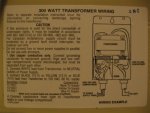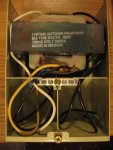I bought an Intermatic PX-300 stepdown transformer to replace the one that feeds my (single) pool light. I hooked it up over the weekend and as soon as I powered it up it started putting out wispy, whitish smoke. It never tripped the breaker, but the supply wires got a little hot before I could trip the breaker myself. I was in the process of testing the voltage on the load side when this happened, and I don't think there was any voltage there. Could be wrong about that, though, since I was rudely interrupted by the smoke. In what I generally consider to be a non-smoking zone, BTW.
The transformer takes in a 3-conductor (hot, neutral and ground) 120 line. On the high voltage side there are 3 choices for the the hot connection depending on whether you want 12, 13 or 14 volt output, and neutral wire and there's a block in the middle for the ground wire. I checked the supply line with a multimeter before doing any connections since my house is a older and you never trust the color of the wire 'round here. I'm positive I didn't cross up the connections.
I did some googling and read in a few places that this was consistent with the transformer having a short, probably on the low voltage side, but I don't really know that much about transformers.
To get to the questions, I took it back to the electrical supply store today and, although they replaced it, they were pretty ***** about it. Pretty much said I must've screwed it up. I don't think so, but thought I would check here in case there's a screwup mode I didn't think about. Is there something important I didn't do? Does anyone know whether a faulty transformer right out of the box is one in a million, one in a thousand, or what; i.e., did I win the lottery or just have a rainy day?
Thanks, Gary
The transformer takes in a 3-conductor (hot, neutral and ground) 120 line. On the high voltage side there are 3 choices for the the hot connection depending on whether you want 12, 13 or 14 volt output, and neutral wire and there's a block in the middle for the ground wire. I checked the supply line with a multimeter before doing any connections since my house is a older and you never trust the color of the wire 'round here. I'm positive I didn't cross up the connections.
I did some googling and read in a few places that this was consistent with the transformer having a short, probably on the low voltage side, but I don't really know that much about transformers.
To get to the questions, I took it back to the electrical supply store today and, although they replaced it, they were pretty ***** about it. Pretty much said I must've screwed it up. I don't think so, but thought I would check here in case there's a screwup mode I didn't think about. Is there something important I didn't do? Does anyone know whether a faulty transformer right out of the box is one in a million, one in a thousand, or what; i.e., did I win the lottery or just have a rainy day?
Thanks, Gary



